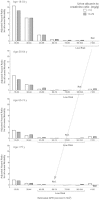An Age-Calibrated Definition of Chronic Kidney Disease: Rationale and Benefits
- PMID: 27057075
- PMCID: PMC4810758
An Age-Calibrated Definition of Chronic Kidney Disease: Rationale and Benefits
Abstract
Defining chronic kidney disease (CKD) is the subject of intense debate in the current nephrology literature. The debate concerns the threshold value of estimated glomerular filtration rate (eGFR) used to make the diagnosis of CKD. Current recommendations argue that a universal threshold of 60 mL/min/1.73m(2) should be used. This threshold has been defended by epidemiological studies showing that the risk of mortality or end-stage renal disease increases with an eGFR below 60 mL/min/1.73m(2). However, a universal threshold does not take into account the physiologic decline in GFR with ageing nor does it account for the risk of mortality and end-stage renal disease being trivial with isolated eGFR levels just below 60 mL/min/1.73m(2) in older subjects and significantly increased with eGFR levels just above 60 mL/min/1.73m(2) among younger patients. Overestimation of the CKD prevalence in the elderly (medicalisation of senescence) and underestimation of CKD (potentially from treatable primary nephrologic diseases) in younger patients is of primary concern. An age-calibrated definition of CKD has been proposed to distinguish age-related from disease-related changes in eGFR. For patients younger than 40 years, CKD is defined by eGFR below 75 mL/min/1.73m(2). For patients with ages between 40 and 65 years, CKD is defined by 60 mL/min/1.73m(2). For subjects older than 65 years without albuminuria or proteinuria, CKD is defined by eGFR below 45 mL/min/1.73m(2).
Figures




References
-
- KDIGO 2012 Clinical Practice Guideline for the Evaluation and Management of Chronic Kidney Disease. Kidney Int Suppl. 2013;3:1–150. - PubMed
-
- Perrone RD, Madias NE, Levey AS. Serum creatinine as an index of renal function: new insights into old concepts. Clin Chem. 1992;38:1933–53. - PubMed
-
- Delanaye P, Mariat C. The applicability of eGFR equations to different populations. Nat Rev Nephrol. 2013;9:513–22. - PubMed
-
- Delanaye P, Pottel H, Botev R, Inker LA, Levey AS. Con: Should we abandon the use of the MDRD equation in favour of the CKD-EPI equation? Nephrol Dial Transplant. 2013;28:1396–403. - PubMed
Grants and funding
LinkOut - more resources
Full Text Sources
Research Materials
Miscellaneous
